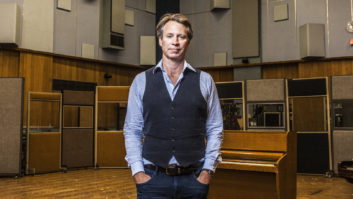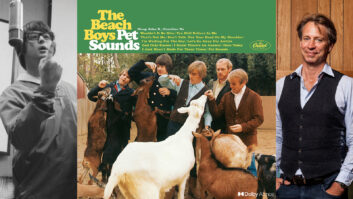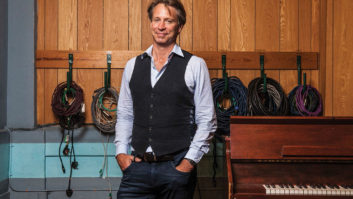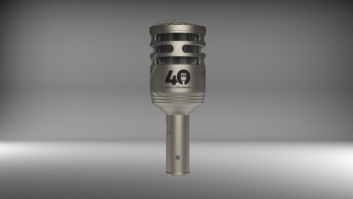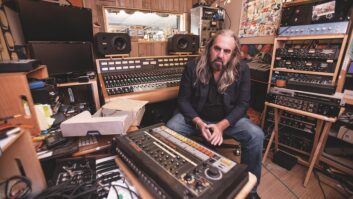
Giles Martin discusses remixing Sgt. Pepper’s Lonely Hearts Club Band for its 50th Anniversary reissue with the press.
At a playback event at Capitol Studios in Hollywood, producer Giles Martin talked at length about remixing the Beatles’ Sgt. Pepper’s Lonely Hearts Club Band for its fiftieth anniversary.
Not every Beatles project has been celebrated on its fiftieth anniversary. As Apple Corps CEO Jeff Jones noted at the Capitol event, “When we did the fiftieth anniversary of the boys on the Ed Sullivan Show, we had an opportunity—it happened around the Grammys and we had CBS interested in creating a television program. But we didn’t do anything for the fiftieth anniversary of Revolver, aside from promoting it and making sure it was available.
“Doing a fiftieth [anniversary edition] of Pepper seemed so obvious. The world was going to celebrate it anyway, so we should make sure that we’re prepared and do something really special for this record.”
Purists may bristle at the idea of anyone even thinking of remixing an album as beloved as Sgt. Pepper, but any Beatles reissue project must first be approved by the band or their estates before it even gets off the ground. “If they like the idea when we propose it, great, we’ll move ahead and do it,” said Jones. “Then we figure out where’s the best place to put it and how to shine the most light on it.”
“People have asked me, ‘Has Paul heard these mixes?’ Well, yeah,” said Martin. “If he hadn’t, I wouldn’t be here. He’s one of my bosses.”
He added: “You only get one chance to do this; it’s a big responsibility.”
Martin took the new mixes to McCartney’s studio for him to hear and approve. “I’m the son of George Martin and in this privileged situation—I do feel humbled by this—but the fact of the matter is you have a man who was responsible for making the greatest album of all time, [and I’m] playing him new mixes that I’ve had to create.”
The playback at McCartney’s studio got to “Fixing a Hole,” Martin recalled. “I said, this is a challenging mix. Because it wasn’t recorded at Abbey Road, it was recorded at Regent Sound and they re-recorded at Abbey Road.
“He said, ‘It was an interesting day, that, because I was home, making myself a cup of tea, and there was a knock at the door. I opened the door’—he lived near Abbey Road—‘and there was a man at the door. He said, ‘Hello, I’m Jesus.’ And Paul said, ‘Well you’d better come in, then.’
“He invited Jesus in and he made him a cup of tea. He said, ‘So, Jesus, I’ve got to go, I’m going to do a recording. You can come with me if you want.’
“So he got in his car and drove Jesus down to Regent Sound and walked into the studios and said, ‘Hey, boys, this is Jesus.’ They all said”—Martin adopted a Liverpool accent—‘Hello, Jesus.’ He sat in the corner and they recorded ‘Fixing a Hole’—in Jesus’ presence.”
“Fixing a Hole” features two bass parts, including McCartney’s, later overdubbed at Abbey Road. “On the tape from Regent Sound—it’s a 4-track tape—I think it’s Paul playing harpsichord, John’s playing bass, Ringo’s playing drums. George is probably talking to Jesus—or arguing with him!” Martin laughed.

Sgt. Pepper’s Lonely Hearts Club Band is being reissued in various formats for its 50th Anniversary, including a “Super Deluxe Box Set.”
The song is among the 30-plus previously unreleased outtakes available on the Pepper reissue package. Before playing an example, Martin said, “This is take three; they used take one. Take three is interesting, because you hear that Paul’s voice is beginning to get tired.”
Another outtake demonstrated that not every idea worked. Martin said, “‘A Day in the Life’ was a very modern recording, in lots of ways, because they knew how it was going to be—like the Beatles did—and they knew they wanted a big E resolved chord. The first idea they had was to have this choral choir, an almost spiritual hum, to finish the album. It turned out to not be the best idea.”
Regarding these bonus tracks, he commented, “The motivation was not to find a better take, it was to show how good the band were. Despite the mysticism, it was four guys who were just a really, really good band that played together, who had a great engineer and a great producer. They consolidated this brilliant sound to a disk. It’s purely physical. That’s what music is; music is a physical experience. It’s not gadgets or gizmos. They help us, but it’s about recording and experiencing music.”
Implicit in the remixes, it seems, is the wish to introduce the album to a new generation of listeners in a form that, with its unusual panning, doesn’t sound odd or archaic. “I just want people to be able to enjoy the music,” said Martin. “A lot of you guys here are deep Beatles fans. We do it so when you tell your children and grandchildren about this, they don’t put it on and say, ‘Why is it coming out of one speaker?’ We do it for that reason.”
This is not the first time that Martin has remixed the Beatles, of course. He previously worked alongside his father, George, on Cirque du Soleil’s Love and has also produced projects such as the remasters for The Beatles: Rock Band video game and the soundtrack for the recent Ron Howard documentary, Eight Days a Week.
“We’ve been doing this for a while, so we tend to recreate the mix setup and then my role, more than anything else, is to screw things up. And to push things, and not to be as respectful as one might think,” he said.
“The advantage of being at Abbey Road is that we have all the stuff that they worked on. Nothing was thrown away; the tapes weren’t thrown away, the machines weren’t thrown away, the desks are still working.”
The Beatles pushed the outside of the technology envelope when they made their original recordings and, decades later, they expected Martin to do the same with the remixes. “I remember 12 years ago, working on the Love project. We knew ‘Help’ was going to be in the show and I couldn’t think what to do with it [in the 5.1 surround remix]. It is what it is. I double-tracked the guitars, and Paul [McCartney] came to listen to it. He said, ‘What’s this? What do we pay you for?’ My father instilled in me pushing the boundaries as much as you can.”
For these remixes, he said, “The first thing I did was chop up the keyboard for ‘Lucy in the Sky with Diamonds’ so it pans. Okay, this is a good template for what we’re doing; this seems to work. Love was different, because the drive was to try and create this new world. This Sgt. Pepper is an embellishment of the world of Sgt. Pepper. The mono is so immersive; you feel like you’re falling into the mono. Now it’s a stereo version.”
But Martin’s creative decisions on the Pepper remixes were ultimately dictated by the songs, not the technology. “It’s all about the song. It’s not about sonic perfection. ‘Fixing a Hole,’ for example, needs that 1 kHz crunch in it, because otherwise it doesn’t sound cool. Music is what’s about in here,” he said, hand over his heart, “not beautiful speakers and studios. It’s about how the songs affect you. That’s the choice we have to make.”
The audio technology available when Pepper was produced was limited. One of the main processing tools used by producer George Martin and the Beatles at that time was the analog tape recorder itself. Martin played the original stereo mix of “She’s Leaving Home.” He then played the original mono mix. “It’s a whole semitone higher,” he noted. “Because that’s what they wanted to do.”
George Martin and the Beatles famously spent weeks on the mono mixes of Pepper, with the stereo mixes produced almost as an afterthought over just a few days, with the band not present. “When they did the stereo [mix], they didn’t pay any attention to tape notes or anything,” said Martin. As a result, the released stereo mix is at the pitch at which it was recorded, not the higher pitch—and consequent faster tempo—that the band preferred for the mono version.
For these anniversary remixes, he said, “It was really paying attention to the notes they did when they mixed it, and putting it into the present.” Martin’s new stereo mix of “She’s Leaving Home” builds on the intent of the original mono mix.

PMC studio monitors were used for the press debut of the Sgt. Pepper’s Lonely Hearts Club Band 50th Anniversary remix.
The creative process on Love was different, he said. “I had the liberty, if there was a frequency I thought was missing, I could add it with another instrument. It was built for surround, so it was a different process. But I think with this we used a lot more ADT [automated or artificial double-tracking]—which is what the Beatles did.”
For instance, he said, “In ‘Getting Better,’ there’s a drop-down section with a tambura. It used to be in one speaker. We ADT’d it and now it’s in two speakers. It creates a much better swirling effect, which I think they would have wanted. It’s that terrible presumption that I had to make.”
Before playing the 1967 stereo mix of “Lucy in the Sky with Diamonds,” Martin said, “My father always said that John [Lennon] hated the sound of his voice and wanted to change everything.” On the mono mixes, Lennon demanded that Martin apply tape delay on his vocals, he said, changing the delay time using a varispeed control in real time as the song was being mixed. “Because you couldn’t bounce it to tape,” he pointed out.
“[Lennon] probably had the knob, and he’s phasing his voice while they’re laying the mix down. Fifty years ago, mixes were performances; a mix was captured live. Nowadays we recall stuff; it’s automated.”
Playing the original version, Martin commented, “This is the mono, with lots of ADT. His voice is far more screwed around with. I think the technical term is ‘fucked around with.’”
He continued, “We used the same ADT. Sam Okell, the mix engineer I work with, spent hours with the varispeed knob.” Unlike the original mixes, he said, “We can actually bounce the ADT; we can record it.”
That said, the ADT on the remixes still had to be a performance. “I’d go and get tea, and Sam would be sitting there with this varispeed knob. If you go too far it goes out of tune. Sometimes he’d ruin my mix; sometimes I’d ruin his. It had to be physical; it’s the Beatles and we have the stuff. Why use a plug-in? There’s great technology that they didn’t have, but when it comes to things like ADT, it is what it is.”
The remixes reveal previously unheard detail, not least because they were created from the original 4-track tapes, not the subsequent second- and third-generation bounces and overdubs. “In all honesty, the tapes that were recorded on sound so amazing. We didn’t do any cleaning up. They just sound great. The drums sounds are amazing. My view is, let’s make people hear that. Because that’s what they were happy with on that day, and I’m not going to put too much crap on top of it,” said Martin.
He rarely even muted individual tracks. “Because it ruins the ambience. For me it ruins the room.” On that “Fixing a Hole” outtake, for example, he said, “The great thing is that you hear the room.”
For the Eight Days a Week soundtrack, Abbey Road Studios technician James Clark developed a process to remove the screams of the crowd from the 3-track master tapes. “It’s a bit like noise cancellation,” said Martin. “Screams are a flatline, a 2.5k thing that does your head in.”
But there was no thought of using a similar process on Pepper. “The problem is that it sometimes creates artifacts, which we try to get rid of. If anything creates an artifact we don’t use it; it sounds awful. I’d rather have dirt. Real life is dirt, so we try not to process,” he said.

The Sgt. Pepper’s Lonely Hearts Club Band 50th Anniversary reissue logo.
That said, Martin did effectively remove one instrument to place it elsewhere in the sound field. “On ‘Sgt. Pepper Reprise,’ I found a way of removing John’s organ and that’s in the left-hand speaker, otherwise it would be mono. We ADT’d the drums and put the organ on one side.”
Martin fully understands the incredibly privileged position in which he finds himself, he said. “I did a demo for Love and it got accepted. I said, do I really want to be doing this? I remember a friend said to me—he’d just mixed the Foo Fighters—‘If you didn’t want to do this, do you have any idea how many people would like to do it?’
“I know I wouldn’t be doing this if I wasn’t the son of George Martin. That’s a legacy to bear; you can’t take that for granted. It’s humbling.
“But we’re so English about stuff. Same planet, different worlds. We spent a long time mixing this, mastering it, trying to get it right. Then we get the first vinyl pressing. I’m with Sam in Studio 3 at Abbey Road and we listen to the vinyl, the first time it was being listened to. Sam turns around to me and goes, ‘It’s less disappointing than I imagined it would be.’”
For even more on the Sgt. Pepper reissue, see the feature story from our June, 2017 issue, Producing The Beatles’ Sgt Pepper Re-Release.
